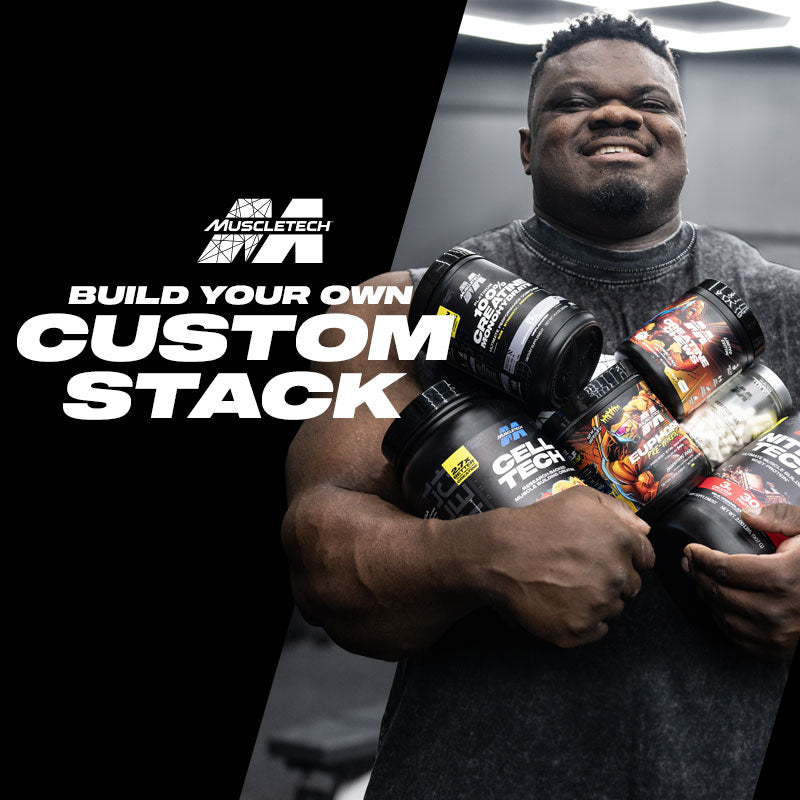By MuscleTech Strength Coach John Porter Jr
In your quest to achieve your fitness goals, have you overlooked conditioning?
Why ask? Because it’s hard. It has a way of exposing weaknesses—whether they’re physical or mental. It also isn’t as sexy as the bicep curls done in the mirror with good lighting.
It can also be confusing. Some people think that cardio and conditioning are the same thing. Though that’s partly true, because they both work the cardio-respiratory system, they differ greatly because of two things: intensity and intention. Though the objectives of cardio are to improve general fitness and overall well-being, the objectives of conditioning are different. They’re centered around performance: improving your capacity to meet the challenge of an athletic event, a fitness test, or even a workout/training session.
Table of content
Cardio Vs. Conditioning
Though cardio is important, conditioning is just as important, especially if you’re an athlete, fitness enthusiast, or weightlifter.
Simply put, better conditioning equals better strength gains.
Why should you add conditioning workouts to your program?
Here’s why:
- Raises metabolism, which can lead to greater fat loss.
- Boosts cardio-respiratory health to support better workouts and improve quality of life.
- Boosts brain function and prevent cognitive decline.
- Builds muscle and improve bone density.
- Increases your mobility.
- Improves your ability to process oxygen effectively. This can help to generate more energy for everything from workouts to the process of post-workout repair.
- Improves your ability to remove waste products out of the muscle during your workouts to help improve workout capacity.
Also Read: 27 HIIT Workouts to Build Muscle & Melt Fat
What does a conditioning workout look like?
Moderate intensity interval training
Moderate intensity interval training (M.I.I.T.) is an ideal way to add conditioning sessions to a workout program. It’s typically done after the strength segment of a workout day so that those strength gains aren’t undermined.
Sample M.I.I.T workout
You will be doing five exercises in one circuit. Use a 40-second/20-second work/rest ratio; that is, perform an exercise for 40 seconds, rest 20 seconds, then perform the next exercise for 40 seconds, then rest 20 seconds, and so on. Rest 90 seconds between each conditioning circuit.
Burpee
- Begin in a standing position. Position your feet shoulder-width apart. Keep your back straight, your chest out, and your arms at your sides.
- Drop into a squat. Bend your knees, driving them out slightly past your toes, while bringing your butt down. Keep your feet flat on the floor. Place your hands on the floor (palms down) in front of your feet.
- Kick your legs back into a high plank position. Your body should be in a straight line from shoulders to heels. Lock your arms in place. Keep your head straight, eyes looking slightly ahead.
- Lower toward the ground. Bend your elbows and bring your body toward the floor. (Basically, perform the bottom part of a push-up.) Keep your body straight and your core tight.
- Rise back to high plank. Focus on keeping your body straight.
- Return to a squat position. Jump your legs forward. When you land, make sure your feet are flat on the floor. Your positioning at the end of this move should be the same as in Step 2.
- Jump! Reach your arms up as you launch toward the ceiling.
Also Read: Bane Workout - The Ultimate Training Program
Tire flip
- Start with your feet and hips shoulder-width apart. Push your hips back to get in the starting position, making sure to keep your back flat and your core engaged.
- Make sure as you underhand grip the tire that you place your hands onto the treads. Putting them in the space between the treads could cause you to hyperextend your fingers or, even worse, tear your biceps.
- Now you’re ready for takeoff. This is an explosive lift, so drive up through your hips. Once the tire is almost vertical, catch it overhand and push it so it topples over onto the floor.
Sledgehammer strike
- Stand about two feet away from the tire with a wide, staggered stance.
- Grip the sledgehammer, first with your left hand at the bottom of the handle and your right hand closer to the head.
- Bring the sledge up. As you do so, slide your right hand toward the head. As you swing down, your right hand will slide down to join your left hand.
- Slam it down as hard as you can against the tire.
- Repeat the sequence for all reps on one side, then switch hands and repeat on the other.
Also Read: How to Train Like an Athlete?
Sled push
- Stand behind the sled and grab the poles with a high-grip hand position.
- Engage your core muscles and start pushing the sled.
- Extend your hips and knees as you move the sled forward.
- Your foot stance should resemble your natural running position.
- Push the sled forward at the desired pace.
Medball slam
- Stand with your feet shoulder-width apart and your knees slightly bent, and hold a four- to six-pound medicine ball in your hand.
- Lift the medicinal ball overhead with your arms extended.
- Look straight ahead and inhale.
- Bend forward at the waist and use your core muscles to throw the ball down in front of your feet with as much force as possible. Contract the abdomen effectively and exhale while doing the exercise.
- Let the arms follow through the movement to prevent falling.
- In the end, your heels should be on the floor and knees slightly bent.
- If it’s a bouncy ball, let the ball bounce back and catch it. If the ball doesn’t bounce, then keep your abdomen contracted and pick up the ball.
- Lift the ball back to the starting position, inhale, and slam.
Also Read: How Can You Work Out Every Day?
How to add conditioning to your programming?
Ultimately, an athlete can add conditioning to their program in two ways:
- Concurrent method: conditioning workouts performed on their own day separate from strength training.
- Conjunction method: conditioning workouts placed at the end of specific days (usually called “finishers”).
I’ll base my samples of each method on a four-times-a-week workout template:
Concurrent method
Day 1: Lower day
- Back squats
- Bulgarian split squats
- Heels-elevated goblet squats
- Seated hamstring curls
- Seated leg extensions
Day 2: Conditioning day
3 rounds of:
- 250 m rows
- 5 burpees
- 10 box jumps
- 15 V-ups
Day 3: Upper day
- Bench press
- Pull-ups
- Arnold press
- EZ-bar curls
- Face pulls
Day 4: Conditioning day
5 rounds of:
- 20-calorie Airdyne bike
- 20-yard bear crawl
- 1 minute jump rope
Conjunction method
Day 1: Lower day
- Back squats
- Bulgarian split squats
- Heels-elevated goblet squats
Finisher: 10 minutes AMRAP
- 20 sledgehammer strikes
- 15-calorie rows
Day 2: Conditioning day
3 rounds of:
- 250 m rows
- 5 burpees
- 10 box jumps
- 15 V-ups
Day 3: Upper day
- Bench press
- Pull-ups
- Arnold press
Finisher: Every two minutes on the minute for five rounds
- Minute 1: Zercher carry (for distance)
- Minute 2: Sled push (for distance)
Day 4: Conditioning Day
5 rounds of:
- 20-calorie Airdyne bike
- 20-yard bear crawl
- 1 minute jump rope
Also Read: Gaining Muscle & Losing Fat
Considerations for Conditioning Workout
- If building strength and/or muscle is the goal, avoid over programming conditioning work. Too much conditioning can reduce your body’s ability to build and retain muscle.
- Breathing heavily and sweating profusely isn’t indicative of a good workout.
- During your conditioning work, do one to four exercises that use primal movements (squat, hinge, push, pull, carry).
- The more muscles used, the greater the metabolic stress, which will yield an improvement in conditioning.
- I suggest keeping the conditioning work under 15 minutes whether you use the concurrent or conjunction method.








